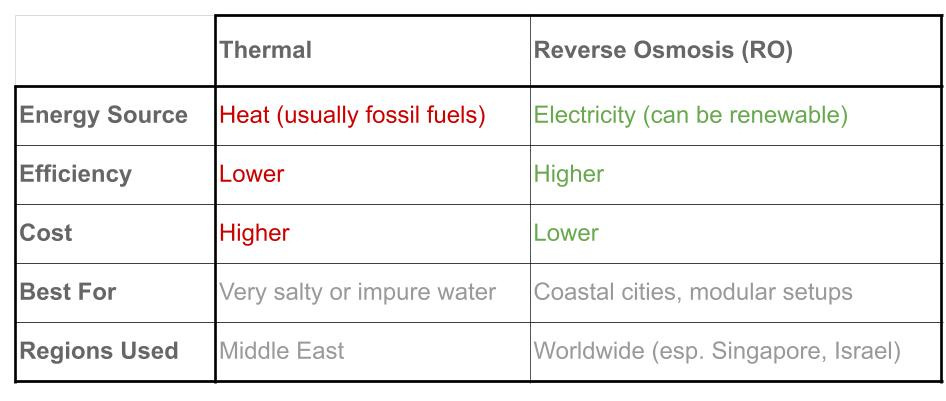Stephen Hawking’s publisher once famously warned him that,
“Each equation you include will halve your readership.”
While that statement is anecdotal and not scientifically precise, it succinctly captures a real phenomenon. And yet, today’s post on IDE Technologies, the world leader in water desalination, demands that we begin with a bit of math and science. I promise to try to make it as clean and refreshing as a glass of glacial water. So, what is water desalination, why does it matter, and what does IDE Technologies do? This is our focus for today.
And now, for the math:
100% of all water on earth = 97.5% seawater + 2.5% freshwater
Where can we find the 2.5% of global water that is freshwater?
100% freshwater = 69% in icecaps & glaciers, 30% buried in the ground, 1% surface water (lakes & rivers)
This means that only about 0.03% of Earth’s total water is easily accessible surface freshwater, which is essential for drinking, farming, and industry. Today, over 2 billion people, approximately 1 in 4 humans, live in water-stressed regions. Without any meaningful interventions, this number is only going higher as both the global population and the intensity of water usage continue to rise. This reality is a humanitarian crisis for those without access to clean water, and an issue of state security for countries without adequate natural water resources.
And now, for the science:
H₂O ≠ H₂O + NaCl + other dissolved ions + trace elements
This equation is what is wrong with seawater. Regular water (H₂O) is terrifc, but seawater is regular water with a bunch of additional sodium chloride (NaCl) and lots of other ions and minerals (e.g. sulfate, magnesium, bromide, etc.), which make it unsuitable for human consumption, agriculture, and industrial use. And, as it turns out, converting seawater into useful freshwater, the process we call desalination, is not easy. This is where IDE Technologies comes in.
IDE Technologies, an Israel-based company, is the global leader in water desalination, and has built major plants all over the world, including Israel, India, China, Singapore, Australia, Chile, Mexico, and the United States. They are experts in both of the two primary desalination methods, which are called thermal and reverse osmosis.
Thermal Desalination works as follows:
Seawater is heated until it evaporates.
The steam rises, leaving salt and minerals behind.
The steam is then condensed back into liquid water (freshwater).
This process handles very salty or polluted water well, but is extremely energy intensive. As such, it is used mainly in energy-rich regions like the Middle East.
Reverse Osmosis uses pressure and semi-permeable membranes to desalinate water, but, before we get into how it works, here is a quick refresher on “what is osmosis?”:
Osmosis is a natural process where water molecules move from an area of low solute concentration (like pure water) to an area of high solute concentration (like salty water) across a semi-permeable membrane, aiming to equalize the concentrations on both sides. Think of it like this: water wants to “dilute” the salt, so it flows into the saltier side.
In reverse osmosis, water is forced to do the opposite of what it does naturally:
By applying pressure to salty (or impure) water, it is pushed through a special membrane that only lets water molecules pass.
The salts, bacteria, impurities, and contaminants are left behind.
Freshwater comes out on one side; brine (concentrated salty water) is discharged from the other.
It doesn’t require heat and can use renewable energy, making it more cost effective and energy-efficient than thermal methods.
Here is a helpful summary table:
Necessity being the “mother of invention” is a concept that is often attributed to Plato but almost certainly predated him. In the case of IDE Technologies, clean water was an absolute necessity for Israel when the company was founded 60 years ago. Since then, they have helped transform the country from a place with chronic water shortages to one of water independence and surplus. Today, around 80% of Israel’s domestic water consumption comes from desalination (and targeted at +90% in the next five years), and the country is currently able to export water to neighboring Jordan. A large IDE Technologies desalination plant helped Singapore achieve water independence from Malaysia and another in California is absolutely vital to the people who live in San Diego.
I think a lot about the global food system, and, as such, I think about water more than most people I know. I’m especially curious about how to ensure that we have the water we need. IDE Technologies was selected today because they are making water possible in places that need it the most. Thanks for reading despite the equations today. (If the opening quote is correct, approximately 12.5% of readers who started this post are still here. However, I’m betting the real percentage is substantially higher, so thank you! In any case, I promise, none tomorrow.)
And friends, that’s a wrap on post #6, only 2,494 to go. See you tomorrow with more from Hopefully Beneficial. Shalom and let’s keep going!






In this case, the equation elicits profound interest… and the staggering numbers confirm the importance of this topic.
I’m quite sure that more than 12.5% of your readers finished reading… and all of us have much to consider if we hope to honor this planet to the best of our ability.
I’m part of the 12.5%! I win. Good post. Water is life.